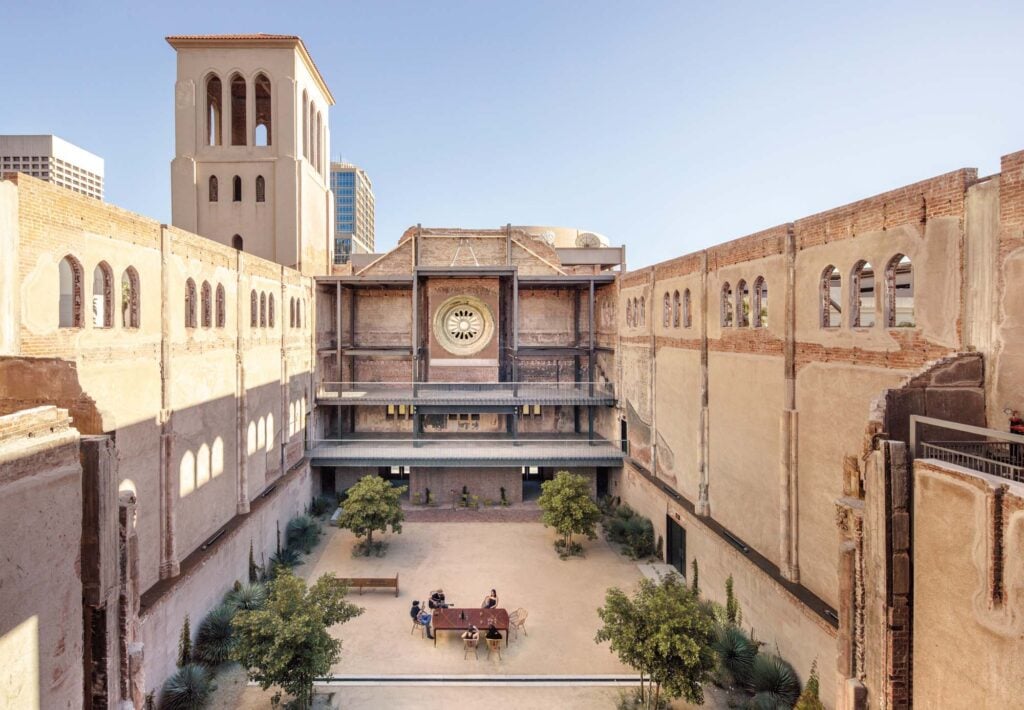
September 28, 2022
Architecture Eats Itself at the 2022 Tallinn Architecture Biennale

In fact, this exhibition is neither but picks up in novel ways where these previous movements hit conceptual dead ends. Instead of using metabolism simply as a metaphor for architectural form, as in the case of the Metabolists, or using architecture as a stage for metabolic acts, as with the millennial support for urban gardens, the curators demand that we see architecture itself as embedded and participating within a nexus of ever-evolving metabolic systems. To carry the thinking further: Good architecture should be able metabolize; to eat itself, break down, reconstitute, and reform in lockstep with the ecological systems with which it is entangled. Standard building practice, in contradistinction, is in a terminal state of indigestion.
To take us on this journey, the curators—Lydia Kallipoliti and Areti Markopoulou in collaboration with chief local advisor Ivan Sergeje—have devised a simple route from small-scale to big. Starting with the section “From Brick to Soil”, we are asked to contemplate different building materials, and the myriad ways in which they can be made edible, upcycled, or composted. In “The Metabolic Home”, we are led around a series of seven room installations, each linking metabolic processes with domestic spaces. And finally, “Food and Geopolitics” challenges us to look at the issue at a regional, national, and planetary scale.

One of the trickier aspects in using metabolism as an agenda for architecture (and as something to show in an exhibition space) is how to give it a legible aesthetic form. After all, metabolism works just great in our intestines, but it certainly isn’t pretty, nor is it immediately apparent how it all takes place. This could be the reason so many projects in the show are focused on facades; a building’s skin is both easy to represent, and readily comparable to the human body. Some of this doesn’t seem to break much new ground though, reworking well-trodden ideas on green facades and organic building materials. Architectural think tank Terreform ONE livens it up a little with Edible Puffed Rice Clusters by proposing to cover desolate buildings in puffed rice, which would be consumed by animals accelerating re-wilding. Meanwhile IAAC (Institute for Advanced Architecture of Catalonia) bring in some Jacques Tati absurdity with Robotic Urban Farmers, a robotic armature, which constantly whizzes about a building’s planted facade, monitoring the growth of plants, and alerting residents when action needs to be taken. Another IAAC project from their Advanced Architecture Group called RootSkin looks at working with root structures, coordinating plant growth so that they leave elaborate post-harvest root meshes. The results are remarkably beautiful, recalling the root weavings of Diana Scherer.
Reuse is another leitmotif pervasive throughout the projects. After all, metabolism is all about processing materials and returning them to a state in which they can be used for other means. In Post-Industrial Zymological Kitchen, by Office for Political Innovation with M-Marble Project, stone off-cuts from quarries are refashioned into a paleolithic worktop (only 30 percent of stone ends up in industrial use). In Robert Charles Johnson’s thrilling short film FATCONOMY: Of Material & Labour, we follow the life of an amateur alchemist named Cooper, who mines waste fats and oils from local restaurants and fashions the lipids into social sculptures.

As with all professions, questions come to architecture in cyclical waves. When they return, however, they are usually informed by a new set of conditions that distinguish them from the past. In this case, the new condition is primarily technological, namely the raft of sensing, data-processing and automation technologies that have already had a profound impact on our agricultural, logistic, and production landscapes. Nowhere is this shift better expressed than in Black Almanac by Andrea Provenzano and Philip Maughan, a lexicon presented both in print and as a film, which charts out the highly-techno-embedded concepts that will shape our planet in order to feed 10 billion people by 2050, from infrastructure to genetics and marketing to microbiology.

Architecture, as ever, is playing catch-up to these technological trends. And throughout the biennale, we see tech gizmos of all sorts get slapped on in sometimes haphazard ways. Machine-readable tags get embedded into rice-puffs, an artificial reef is 3D-printed rather than slip-cast, robots do the gardening instead of humans. Outside the museum is an Instagram-friendly Jenga-block-like pavilion, which piles on the buzzwords: a structure crowd-funded through NFT and block-chain technology, informed by “mixed realities” and machine-learning alongside community enabled decision-making. Called Fungible Non-Fungible by the research-design studio iheartblob, it’s the winning entry in the Slow Building competition, which called for proposals to translate the ethos of the Slow Food movement into building practice. While the typical visitor—myself included—might struggle to grasp a tenth of what this project is all about, the experimental thrust is exciting nonetheless, and it seems overall fitting for such work to be shown in a country like Estonia, itself a leader on many technological fronts.
In general, these technological connections shouldn’t be taken as superficial, or trend-hopping, yet rather a productive instance of throwing ideas at the wall to see what sticks. This is precisely the advantage that biennales like this play—as one of the remaining experimental safe spaces for open speculation in a results-and metrics-oriented society. The Tallinn Architecture Biennale provides such speculation as a multi-course feast, best approached with an open mind and empty stomach.
Would you like to comment on this article? Send your thoughts to: [email protected]
Latest
Viewpoints
3 Sustainability News Updates for Q3 2024
Policy initiatives are gathering momentum as the federal government and building sector organizations align their expertise under the umbrella of the Inflation Reduction Act.
Products
The Anthros Chair Goes Beyond Ergonomics
A brand-new task chair comes out of decades-long evidence-based research into wheelchair design and the human body.
Projects
Monroe Street Abbey Is an Armature from the Past for the Future
Discover how Jones Studio transformed the ruins of a former Baptist church in Phoenix into a community-centered garden and event venue.









